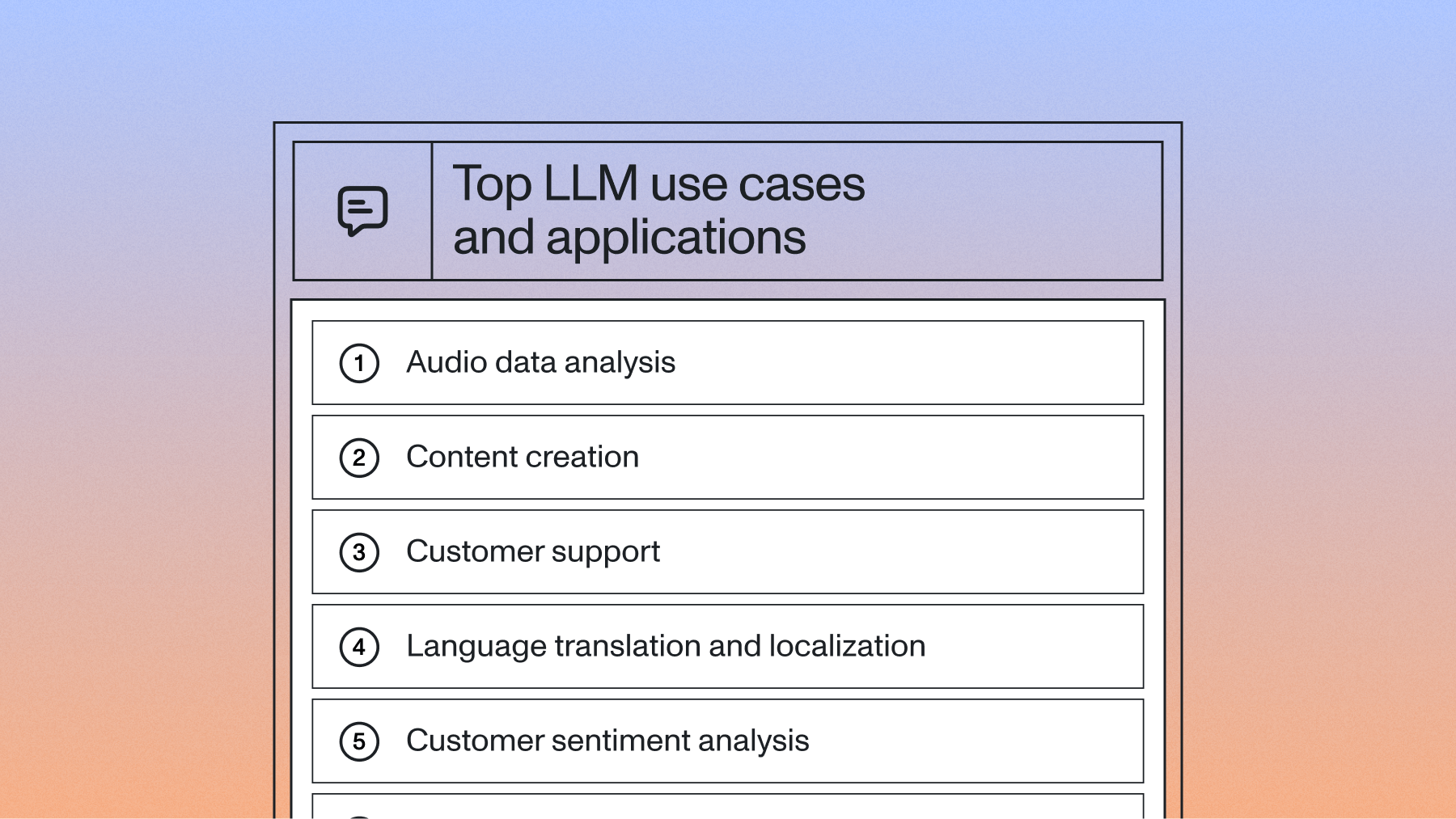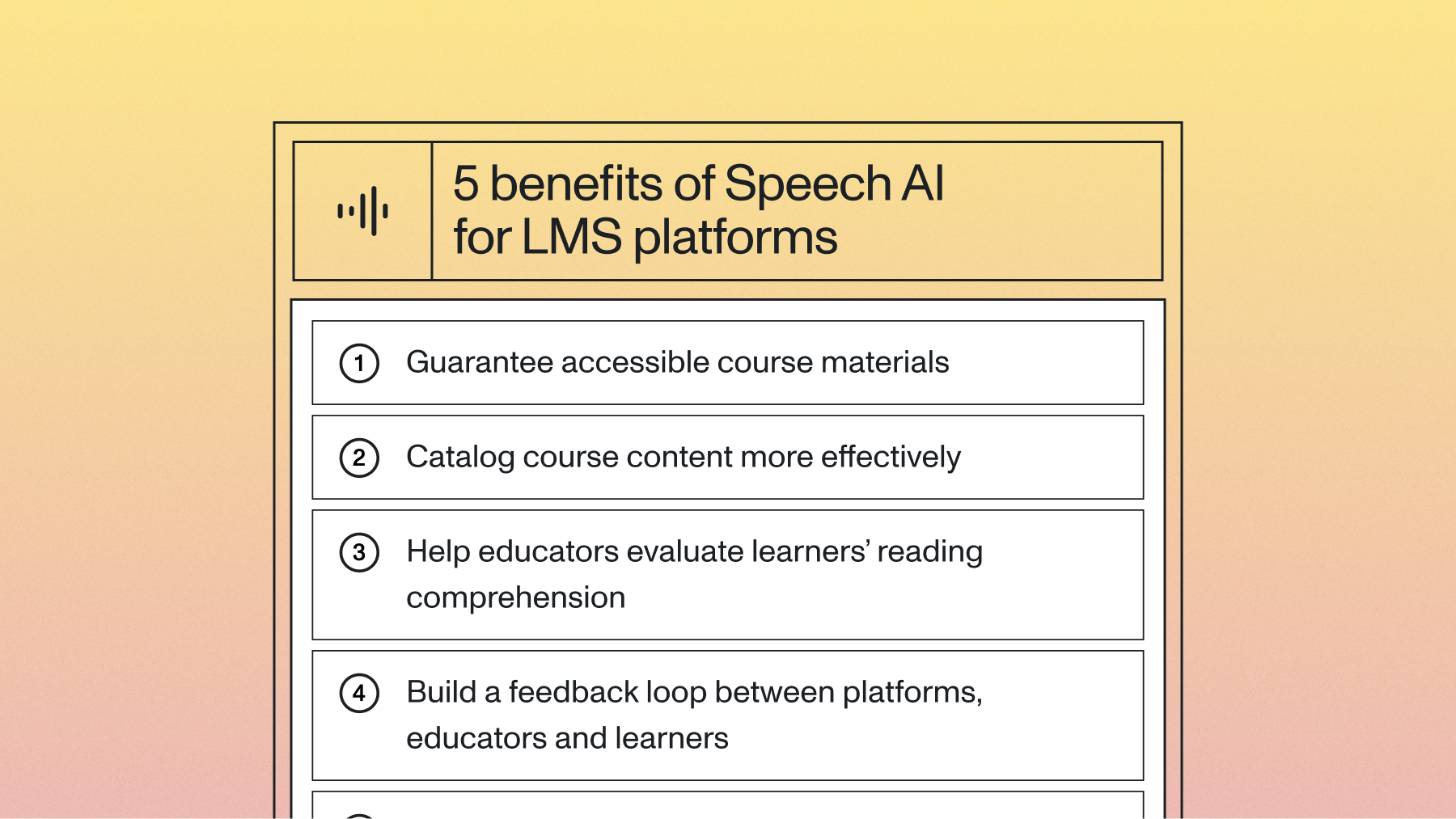How to use AI to build powerful market research tools
Learn how AI models can enhance market research tools and customer research platforms.



Market research platforms offer users valuable market research tools that analyze qualitative and quantitative audio, video, and text-based customer feedback, so users can gain insights from the data. Today, market research platforms are turning to AI models, such as AI Speech-to-Text, Audio Intelligence models, and Large Language Models (LLMs), to build suites of advanced analysis tools for their customers.
This article examines how AI models can be leveraged to help market research platforms build powerful tools that can:
- Transcribe asynchronous and live voice and video feedback to make review and analysis more efficient.
- Generate key themes and highlights to speed up research analysis.
- Produce digestible insights that can be easily categorized, tagged, and searched.
First, we’ll look at what a market research platform is before diving into the top three ways that AI models can be used to build standout market research tools.
What is a market research platform?
A market research platform serves as a large customer knowledge database and command center. Market research platforms aggregate video, audio, and text-based customer feedback, housing the data in one collective and searchable platform. The platform typically features analysis tools that can identify patterns and themes in customer responses to generate insights that can be turned into specific, results-driven actions for users.
For example, one market research platform helps inform healthcare marketing by comparing respondents’ descriptions of pharmaceuticals to brand messaging.
Other platforms use thematic clustering to analyze qualitative data from open-ended survey questions to generate action items for companies.
Because most of the customer feedback consists of voice and video responses, market research platforms are investing in Speech AI models to build AI-powered customer analysis tools.
Benefits of Speech AI for market research
Thanks to significant advances in AI research, today’s Speech AI models are the most accurate, affordable, and accessible they’ve ever been.
Top Speech-to-Text APIs, for example, can transcribe audio and video stream data, like customer survey responses, at near-perfect accuracy for both asynchronous and real-time transcription.
Audio Intelligence models enable users to dig into customer research in more depth. For example, users can automatically generate key highlights from survey responses, analyze customer sentiment, categorize and tag conversations, and more. Market research platforms can leverage both Speech-to-Text and Audio Intelligence models to offer more robust tools for their own customers.
In addition, market research platforms are harnessing the power of Large Language Models, or LLMs, to streamline the analysis of data and offer even more advanced tools that can generate custom summaries, list action items, or provide answers to specific questions.
Next, let’s look at the three ways market research platforms can benefit from leveraging Speech AI technology.
1. Create accurate transcripts from voice and video surveys
Using AI Speech-to-Text to transcribe voice and video feedback makes the customer data review and analysis process significantly more efficient. Today’s AI speech transcription models are more accurate than ever before. For example, Conformer-2 was trained on 1.1 million hours of voice data to achieve near-human accuracy, as well as significant improvements to proper noun and alphanumerics accuracy and considerable robustness to noise.
High transcription readability also significantly increases the utility of transcripts. Many models, for example, display a transcription that lacks basic punctuation and casing, paragraph structure, and speaker labels, making it difficult to read.
The following transcription is an example of what you’d see if you use a speech-to-text AI model with poor accuracy:
But how did you guys first meet and how do you guys know each other? I
actually met her not too long ago. I met her, I think last year in
December, during pre season, we were both practicing at Carson a lot.
And then we kind of met through other players. And then I saw her a few
her last few torments this year, and we would just practice together
sometimes, and she's really, really nice. I obviously already knew who
she was because she was so good. Right.So.
To fix this problem, top Speech-to-Text APIs offer Automatic Casing and Punctuation and Paragraph Detection models that automatically format transcription texts with appropriate paragraph structure, sentence structure, capitalization, and punctuation, making them much more readable. Some also offer Speaker Diarization models that automatically detect and label multiple speakers in an audio or video stream.
Here’s what a transcript with these features included looks like:
<Speaker A> But how did you guys first meet and how do you guys know each
Other?
<Speaker B> I actually met her not too long ago. I met her, I think last
year in December, during pre season, we were both practicing at Carson a
lot. And then we kind of met through other players. And then I saw her a
few her last few torments this year, and we would just practice together
sometimes, and she's really, really nice. I obviously already knew who
she was because she was so good.
<Speaker A> Right. So.
LLMs can also accurately predict the names of the speakers in the transcription text, which can be used to replace the generic “speaker A, B, C, etc.” label.
Also consider if companies using the platform need to publish user research feedback, externally or internally, without surfacing exactly who gave the feedback. Or maybe the survey data contains private or sensitive information, like medical data or phone numbers or addresses, that could violate GDPR or HIPAA regulations.
If this is the case, PII Redaction models can automatically remove Personally Identifiable Information (PII) from a transcription text, replacing any desired redacted items with a # instead.
This table shows the types of PII that can commonly be redacted:
2. Generate key highlights and analysis
In addition to providing highly accurate, readable transcripts, market research tools help their customers make sense of these responses. For example, some market research tools automatically generate highlights and key analyses from the transcription data. Or a market research tool may create a highlight reel of the most important and/or sensitive segments of customer data that need to be surfaced.
There are a few Audio Intelligence models that work together to achieve this sophisticated analysis. The first is a Text Summarization model. Text Summarization models generate short overviews of the voice data, helping customers review survey results more quickly.
LLMs can also be used to customize summaries or provide additional context that’s not explicitly referenced in the voice data that is important to the understanding of the summary output.
Learn how to get a custom summary of audio files in this video tutorial
Entity Detection, or Named Entity Recognition, models identify and classify important information in the transcription text. For example, “San Francisco” is an entity that is classified as a “location.”
With Entity Detection, market research platforms can build tools that help their customers identify commonly recurring entities, such as company names, locations, and occupations, and compile them for further analysis.
Other common entities that can be detected and classified with an Entity Detection API include:
Topic Detection models can work in conjunction with Entity Detection as well. Topic Detection models identify and label topics in the transcription text, also helping end users identify patterns in customer responses. Topics are classified using the IAB Taxonomy, a compilation of commonly identifiable topics:
Sentiment Analysis models provide strategic insights by accurately labeling speech segments in a transcription text as positive, negative, or neutral. Market research platforms can use Sentiment Analysis models to build tools that help their customers track and analyze customer feedback about products, services, companies, and more—both in individual survey responses and across collected responses as a whole.
When used together, Audio Intelligence models like Summarization, Entity Detection, Topic Detection, and Sentiment Analysis can help market research platforms provide true insight into customer behaviors and attitudes.
3. Categorize, tag, and search responses
Market research tools also help users quickly categorize, tag, and search gigabytes of qualitative and quantitative research data. This could include providing searchable topics and categories, similar to the use of hashtags on Twitter, or even automatically trimming and editing survey responses for each searchable tag.
These “auto” or “smart” tags can be powerful filters that help users sift through the large volume of voice data and locate the customer opinions that matter to inform actions or goals.
Simply transcribing the audio/video data is an important first step to being able to search through a transcript and locate keywords or phrases quickly. However, Audio Intelligence models such as Summarization, Entity Detection, and Topic Detection can also be used to bundle this process into an easy-to-use tool for customers.
Entity Detection and Topic Detection models, for example, can identify and label the common themes in the survey data. The market research tool can then use this informed data to generate smart tags that represent key bits of information an end user might want to search for. Then, Summarization models or LLMs can provide a contextually based summary of important segments of the survey response that can be attached to that tag.
AI-powered market research tools
Speech AI models like AI Speech-to-Text, Audio Intelligence, and LLMs help market research platforms build out intelligent feature sets with highly accurate transcripts, automated key highlights and analysis, and more. Leading companies like Marvin, a qualitative data analysis platform, recognize the power of AI and are already offering their customers new market research tools using Speech AI technology. As a result, their customers are spending 60% less time analyzing customer data while also gaining key insights from enormous amounts of customer survey responses.
To build the next generation of market research tools, platforms must leverage state-of-the-art AI technologies to offer competitive products and services to their customers.
Play around with powerful AI models in AssemblyAI’s free, no-code playground. Play here
Lorem ipsum dolor sit amet, consectetur adipiscing elit, sed do eiusmod tempor incididunt ut labore et dolore magna aliqua. Ut enim ad minim veniam, quis nostrud exercitation ullamco laboris nisi ut aliquip ex ea commodo consequat. Duis aute irure dolor in reprehenderit in voluptate velit esse cillum dolore eu fugiat nulla pariatur.




%20is%20Being%20Used%20Today.png)